Characterization of Novel Solid Dispersions of Moringa oleifera Leaf Powder Using Thermo-Analytical Techniques
Abstract
1. Introduction
2. Materials and Methods
2.1. Source of Materials
2.2. Preparation of Solid Dispersions
2.2.1. Preparation of Solid Dispersion by the Solvent Evaporation Method
2.2.2. Preparation of Solid Dispersion by Freeze-Drying Method
2.2.3. Preparation of Solid Dispersion by Melting Method
2.2.4. Preparation of Solid Dispersion by Microwave Method
2.3. Characterization of the MOLP and Solid-Dispersed MOLPs
2.3.1. Powder X-ray Diffraction (PXRD) Analysis
2.3.2. Deferential Scanning Calorimetry
2.3.3. Thermo-Gravimetric Analysis
2.3.4. Fourier Transform Infrared (FTIR) Spectroscopy Analysis
2.4. Data Analysis
3. Results and Discussion
3.1. Crystallinity of MOLP and MOLPs Determined by Powder X-ray Diffraction
PXRD Patterns of Solid Dispersions
3.2. Thermal Properties of MOLP and SDMOLPs
3.3. Thermogravimetric Properties of MOLP and SDMOLPs
3.4. Fourier Transform Infrared (FTIR) Spectra of MOLP and SDMOLPs
4. Conclusions
Author Contributions
Funding
Institutional Review Board Statement
Informed Consent Statement
Data Availability Statement
Acknowledgments
Conflicts of Interest
References
- Zhu, Q.; Harris, M.T.; Taylor, L.S. Modification of crystallization behavior in drug/polyethylene glycol solid dispersions. Mol. Pharm. 2012, 9, 546–553. [Google Scholar] [CrossRef] [PubMed]
- Lan, Y.; Xu, M.; Ohm, J.B.; Chen, B.; Rao, J. Solid dispersion-based spray-drying improves solubility and mitigates beany flavour of pea protein isolate. Food Chem. 2019, 278, 665–673. [Google Scholar] [CrossRef] [PubMed]
- Zawar, L.; Bari, S. Microwave Induced Solid Dispersion as a Novel Technique for Enhancing Dissolution Rate of Repaglinide. Adv. Pharmacol. Pharm. 2013, 1, 95–101. [Google Scholar] [CrossRef]
- Alshehri, S.; Imam, S.S.; Altamimi, M.A.; Hussain, A.; Shakeel, F.; Elzayat, E.; Mohsin, K.; Ibrahim, M.; Alanazi, F. Enhanced Dissolution of Luteolin by Solid Dispersion Prepared by Different Methods: Physicochemical Characterization and Antioxidant Activity. ACS Omega 2020, 5, 6461–6471. [Google Scholar] [CrossRef]
- Ishimoto, K.; Miki, S.; Ohno, A.; Nakamura, Y.; Otani, S.; Nakamura, M.; Nakagawa, S. β-Carotene solid dispersion prepared by hot-melt technology improves its solubility in water. J. Food Sci. Technol. 2019, 56, 3540–3546. [Google Scholar] [CrossRef]
- Weerapol, Y.; Tubtimsri, S.; Jansakul, C.; Sriamornsak, P. Improved dissolution of Kaempferia parviflora extract for oral administration by preparing solid dispersion via solvent evaporation. Asian J. Pharm. Sci. 2017, 12, 124–133. [Google Scholar] [CrossRef]
- Huang, X.; Liang, K.H.; Liu, Q.; Qiu, J.; Wang, J.; Zhu, H. Superfine grinding affects physicochemical, thermal and structural properties of Moringa Oleifera leaf powders. Ind. Crops Prod. 2020, 151, 112472. [Google Scholar] [CrossRef]
- Bolourchian, N.; Mahboobian, M.M.; Dadashzadeh, S. The effect of PEG molecular weights on dissolution behavior of simvastatin in solid dispersions. Iran. J. Pharm. Res. 2013, 12, 9–18. [Google Scholar]
- Ma, X.; Williams, R.O. Characterization of amorphous solid dispersions: An update. J. Drug Deliv. Sci. Technol. 2019, 50, 113–124. [Google Scholar] [CrossRef]
- Janssens, S.; Van den Mooter, G. Review: Physical chemistry of solid dispersions. J. Pharm. Pharmacol. 2009, 61, 1571–1586. [Google Scholar] [CrossRef]
- Recharla, N.; Riaz, M.; Ko, S.; Park, S. Novel technologies to enhance solubility of food-derived bioactive compounds: A review. J. Funct. Foods 2017, 39, 63–73. [Google Scholar] [CrossRef]
- Hassouna, F.; Abo El Dahab, M.; Fulem, M.; De Lima Haiek, A.; Laachachi, A.; Kopecký, D.; Šoóš, M. Multi-scale analysis of amorphous solid dispersions prepared by freeze drying of ibuprofen loaded acrylic polymer nanoparticles. J. Drug Deliv. Sci. Technol. 2019, 53, 101182. [Google Scholar] [CrossRef]
- Zhao, C.; Cheng, H.; Jiang, P.; Yao, Y.; Han, J. Preparation of lutein-loaded particles for improving solubility and stability by Polyvinylpyrrolidone (PVP) as an emulsion-stabilizer. Food Chem. 2014, 156, 123–128. [Google Scholar] [CrossRef] [PubMed]
- Alshehri, S.; Shakeel, F.; Ibrahim, M.; Elzayat, E.; Altamimi, M.; Shazly, G.; Mohsin, K.; Alkholief, M.; Alsulays, B.; Alshetaili, A.; et al. Influence of the microwave technology on solid dispersions of mefenamic acid and flufenamic acid. PLoS ONE 2017, 12, e0182011. [Google Scholar] [CrossRef]
- Oliete, B.; Potin, F.; Cases, E.; Saurel, R. Microfluidization as Homogenization Technique in Pea Globulin-Based Emulsions. Food Bioprocess Technol. 2019, 877–882. [Google Scholar] [CrossRef]
- Delgado, A.Y.C.; Velásquez, H.J.C.; Molina, D.A.R. Thermal and thermodynamic characterization of a dye powder from liquid turmeric extracts by spray drying. Rev. Fac. Nac. Agron. Medellin 2016, 69, 7845–7854. [Google Scholar] [CrossRef]
- Sharma, V. A Review on Characterization of Solid Dispersion. Int. J. Eng. Appl. Sci. Technol. 2019, 4, 127–128. [Google Scholar] [CrossRef]
- Pang, S.; Ma, C.; Zhang, N.; He, L. Investigation of the solubility enhancement mechanism of rebaudioside D using a solid dispersion technique with potassium sorbate as a carrier. Food Chem. 2015, 174, 564–570. [Google Scholar] [CrossRef] [PubMed]
- Raj, A.L.; Kumar, Y.S. Preparation and Evaluation of Solid Dispersion of Nebivolol Using Solvent Evaporation Method. Int. J. Pharm. Sci. Drug Res. 2018, 10, 322–328. [Google Scholar] [CrossRef]
- da Silva, K.M.A.; de Lima Ramos Júnior, F.J.; Júnior, J.V.C.; Brandão, D.O.; Lins, T.B.; Macêdo, R.O.; de Souza, F.S. Characterization of solid dispersions of a powerful statin using thermoanalytical techniques. J. Therm. Anal. Calorim. 2019, 138, 3701–3714. [Google Scholar] [CrossRef]
- Enose, A.A.; Dasan, P.K.; Sivaramakrishnan, H.; Shah, S.M. Formulation and Characterization of Solid Dispersion Prepared by Hot Melt Mixing: A Fast Screening Approach for Polymer Selection. J. Pharm. 2014, 2014, 105382. [Google Scholar] [CrossRef]
- Fitriani, L.; Haqi, A.; Zaini, E. Preparation and characterization of solid dispersion freeze-dried efavirenz—Polyvinylpyrrolidone K-30. J. Adv. Pharm. Technol. Res. 2016, 7, 105–109. [Google Scholar] [CrossRef] [PubMed]
- Mogal, S.A.; Gurjar, P.N.; Yamgar, D.S.; Kamod, A.C. Solid dispersion technique for improving solubility of some poorly soluble drugs. Der Pharm. Lett. 2012, 4, 1574–1586. [Google Scholar]
- Khatri, P.; Shah, M.K.; Patel, N.; Jain, S.; Vora, N.; Lin, S. Preparation and characterization of pyrimethamine solid dispersions and an evaluation of the physical nature of pyrimethamine in solid dispersions. J. Drug Deliv. Sci. Technol. 2018, 45, 110–123. [Google Scholar] [CrossRef]
- Moyo, B.; Masika, P.J.; Hugo, A.; Muchenje, V. Nutritional characterization of Moringa (Moringa oleifera Lam.) leaves. African J. Biotechnol. 2011, 10, 12925–12933. [Google Scholar]
- Gopalakrishnan, L.; Doriya, K.; Santhosh, D. Moringa oleifera: A review on nutritive importance and its medicinal application. Food Sci. Hum. Wellness 2016, 5, 49–56. [Google Scholar] [CrossRef]
- Ferreira, L.F.; de Oliveira, A.C.S.; de Oliveira Begali, D.; de Sena Neto, A.R.; Martins, M.A.; de Oliveira, J.E.; Borges, S.V.; Yoshida, M.I.; Tonoli, G.H.D.; Dias, M.V. Characterization of cassava starch/soy protein isolate blends obtained by extrusion and thermocompression. Ind. Crops Prod. 2021, 160, 113092. [Google Scholar] [CrossRef]
- Fernandes, M.C.; Sellappan, K. Elemental composition and X-ray diffraction studies of strobilanthes species. Indian J. Biochem. Biophys. 2019, 56, 144–149. [Google Scholar]
- Fernandes, F.H.A.; De Almeida, V.E.; De Medeiros, F.D.; Da Silva, P.C.D.; Da Simões, M.O.S.; Veras, G.; Medeiros, A.C.D. Evaluation of compatibility between Schinopsis brasiliensis Engler extract and pharmaceutical excipients using analytical techniques associated with chemometric tools. J. Therm. Anal. Calorim. 2016, 123, 2531–2542. [Google Scholar] [CrossRef]
- Araújo, C.S.T.; Alves, V.N.; Rezende, H.C.; Almeida, I.L.S.; De Assunção, R.M.N.; Tarley, C.R.T.; Segatelli, M.G.; Coelho, N.M.M. Characterization and use of Moringa oleifera seeds as biosorbent for removing metal ions from aqueous effluents. Water Sci. Technol. 2010, 62, 2198–2203. [Google Scholar] [CrossRef]
- Vasa, D.M.; Dalal, N.; Katz, J.M.; Roopwani, R.; Nevrekar, A.; Patel, H.; Buckner, I.S.; Wildfong, P.L.D. Physical characterization of drug:Polymer dispersion behavior in polyethylene glycol 4000 solid dispersions using a suite of complementary analytical techniques. J. Pharm. Sci. 2014, 103, 2911–2923. [Google Scholar] [CrossRef]
- Obaidat, R.; Al-taani, B.; Al-quraan, H. Effect of Selected Polymers on Dissolution and Stabilization of Amorphous Form of Meloxicam. Int. J. Pharm. Pharm. Sci. 2017, 9, 33. [Google Scholar] [CrossRef][Green Version]
- Jayaramudu, T.; Raghavendra, G.M.; Varaprasad, K.; Reddy, G.V.S.; Reddy, A.B.; Sudhakar, K.; Sadiku, E.R. Preparation and characterization of poly(ethylene glycol) stabilized nano silver particles by a mechanochemical assisted ball mill process. J. Appl. Polym. Sci. 2016, 133. [Google Scholar] [CrossRef]
- Kou, Y.; Wang, S.; Luo, J.; Sun, K.; Zhang, J.; Tan, Z.; Shi, Q. Thermal analysis and heat capacity study of polyethylene glycol (PEG) phase change materials for thermal energy storage applications. J. Chem. Thermodyn. 2019, 128, 259–274. [Google Scholar] [CrossRef]
- Krstić, M.; Manić, L.; Martić, N.; Vasiljević, D.; Mračević, S.Đ.; Vukmirović, S.; Rašković, A. Binary polymeric amorphous carvedilol solid dispersions: In vitro and in vivo characterization. Eur. J. Pharm. Sci. Off. J. Eur. Fed. Pharm. Sci. 2020, 150, 105343. [Google Scholar] [CrossRef]
- Tran, T.T.D.; Tran, P.H.L. Molecular interactions in solid dispersions of poorly water-soluble drugs. Pharmaceutics 2020, 12, 745. [Google Scholar] [CrossRef]
- Patel, R.P.; Patel, D.J.; Bhimani, D.B.; Patel, J.K. Physicochemical characterization and dissolution study of solid dispersions of furosemide with polyethylene glycol 6000 and polyvinylpyrrolidone k30. Dissolution Technol. 2008, 15, 17–25. [Google Scholar] [CrossRef]
- Muthu, M.J.; Kavitha, K.; Chitra, K.S.; Nandhineeswari, S. Soluble curcumin prepared by solid dispersion using four different carriers: Phase solubility, molecular modelling and physicochemical characterization. Trop. J. Pharm. Res. 2019, 18, 1581–1588. [Google Scholar]
- Jeyakumar, N.; Narayanasamy, B.; Balasubramanian, D.; Viswanathan, K. Characterization and effect of Moringa Oleifera Lam. antioxidant additive on the storage stability of Jatropha biodiesel. Fuel 2020, 281, 118614. [Google Scholar] [CrossRef]
- Hugo, F.; Fernandes, A.; Santana, C.; Correia, L.P. Thermal characterization of dried extract of medicinal plant by DSC and analytical techniques. J. Ther. Anal. Calorim. 2013, 113, 443–447. [Google Scholar] [CrossRef]
- Dzulhi, S.; Anwar, E.; Nurhayati, T. Formulation, Characterization and In Vitro Skin Penetration of Green tea (Camellia sinensis L.) Leaves Extract-Loaded Solid Lipid Nanoparticles. J. Appl. Pharm. Sci. 2018, 8, 57–62. [Google Scholar] [CrossRef]
- Pandit, A.P.; Joshi, S.R.; Dalal, P.S.; Patole, V.C. Curcumin as a permeability enhancer enhanced the antihyperlipidemic activity of dietary green tea extract. BMC Complementary Altern. Med. 2019, 1, 129. [Google Scholar] [CrossRef]
- El Maghraby, G.M.; Elsergany, R.N. Fast disintegrating tablets of nisoldipine for intra-oral administration. Pharm. Dev. Technol. 2014, 19, 641–650. [Google Scholar] [CrossRef]
- Biswal, S.; Sahoo, J.; Murthy, P.N.; Giradkar, R.P.; Avari, J.G. Enhancement of dissolution rate of gliclazide using solid dispersions with polyethylene glycol 6000. AAPS PharmSciTech 2008, 9, 563–570. [Google Scholar] [CrossRef] [PubMed]
- Ali, M.A.; Yusof, Y.A.; Chin, N.L.; Ibrahim, M.N. Processing of Moringa leaves as natural source of nutrients by optimization of drying and grinding mechanism. J. Food Process Eng. 2017, 40, e12583. [Google Scholar] [CrossRef]
- Valdez-Solana, M.A.; Mejía-García, V.Y.; Téllez-Valencia, A.; García-Arenas, G.; Salas-Pacheco, J.; Alba-Romero, J.J.; Sierra-Campos, E. Nutritional content and elemental and phytochemical analyses of moringa oleifera grown in Mexico. J. Chem. 2015, 2015, 860381. [Google Scholar] [CrossRef]
- Mikore, D.; Mulugeta, E. Determination of proximate and mineral compositions of Moringa oleifera and Moringa stenopetala leaves cultivated in Arbaminch Zuria and Konso, Ethiopia. Afr. J. Biotechnol. 2017, 16, 808–818. [Google Scholar] [CrossRef]
- Malucelli, L.C.; Massulo, T.; Magalhães, W.L.E.; Stofella, N.C.F.; Vasconcelos, E.C.; Aurélio, M.; Filho, S.C.; Murakami, F.S. Thermal and chemical characterization of Dicksonia sellowiana extract by means of thermal analysis. Rev. Bras. Farmacogn. 2018, 28, 626–630. [Google Scholar] [CrossRef]
- Su, B.; Chen, X. Current Status and Potential of Moringa oleifera Leaf as an Alternative Protein Source for Animal Feeds. Front. Vet. Sci. 2020, 7, 53. [Google Scholar] [CrossRef] [PubMed]
- Li, L.; Yao, X.; Li, H.; Liu, Z.; Ma, W.; Liang, X. Thermal stability of oxygen-containing functional groups on activated carbon surfaces in a thermal oxidative environment. J. Chem. Eng. Japan 2014, 47, 21–27. [Google Scholar] [CrossRef]
- Bello, O.S.; Adegoke, K.A.; Akinyunni, O.O. Preparation and characterization of a novel adsorbent from Moringa oleifera leaf. Appl. Water Sci. 2017, 7, 1295–1305. [Google Scholar] [CrossRef]
- Ram, V.R.; Ram, P.N.; Khatri, T.T.; Vyas, S.J.; Dave, P.N. Thermal analytical characteristics by TGA-DTA-DSC analysis of Carica papaya leaves from Kachchh. Int. Lett. Natl. Sci. 2014, 26, 12–20. [Google Scholar] [CrossRef]
- Regdon, G.; Korteby, Y. Quantitative and qualitative use of thermal analysis for the investigation of the properties of granules during fluid bed melt granulation. J. Therm. Anal. Calorim. 2018, 133, 619–632. [Google Scholar] [CrossRef]
- Zeng, Q.; Ou, L.; Zhao, G.; Cai, P.; Liao, Z.; Dong, W.; Liang, X.; Tao, Y. Preparation and Characterization of PEG4000 Palmitate/PEG8000 Palmitate-Solid Dispersion Containing the Poorly Water-Soluble Drug Andrographolide. Adv. Polym. Technol. 2020, 2020, 4239207. [Google Scholar] [CrossRef]
- Tran, T.L.N.; Miranda, A.F.; Mouradov, A.; Adhikari, B. Physicochemical characteristics of protein isolated from thraustochytrid oilcake. Foods 2020, 9, 779. [Google Scholar] [CrossRef]
- Matinise, N.; Fuku, X.G.; Kaviyarasu, K.; Mayedwa, N.; Maaza, M. ZnO nanoparticles via Moringa oleifera green synthesis: Physical properties & mechanism of formation. Appl. Surf. Sci. 2017, 406, 339–347. [Google Scholar] [CrossRef]
- Girma, T.; Abebaw, A.; Dube, S. Study on adsorption of some common metal ions present in industrial effluents by Moringa stenopetala seed powder Journal of Environmental Chemical Engineering Study on adsorption of some common metal ions present in industrial e ffl uents by Moringa steno. J. Environ. Chem. Eng. 2018, 6, 1378–1389. [Google Scholar] [CrossRef]
- Shameli, K.; Bin Ahmad, M.; Jazayeri, S.D.; Sedaghat, S.; Shabanzadeh, P.; Jahangirian, H.; Mahdavi, M.; Abdollahi, Y. Synthesis and characterization of polyethylene glycol mediated silver nanoparticles by the green method. Int. J. Mol. Sci. 2012, 13, 6639–6650. [Google Scholar] [CrossRef] [PubMed]
- Kumavat, S.; Chaudhari, Y.; Borole, P.; Shenghani, K.; Badhe, M. Enhancement of Solubility and Dissolution Rate of Curcumin By Solid Dispersion Technique. Int. Res. J. Pharm. 2013, 4, 226–232. [Google Scholar] [CrossRef]
- Guedes, F.L.; De Oliveira, B.G.; Hernandes, M.Z.; De Simone, C.A.; Veiga, F.J.B.; De Lima, M.D.C.A.; Pitta, I.R.; Galdino, S.L.; Neto, P.J.R. Solid dispersions of imidazolidinedione by PEG and PVP polymers with potential antischistosomal activities. AAPS PharmSciTech 2011, 12, 401–410. [Google Scholar] [CrossRef]
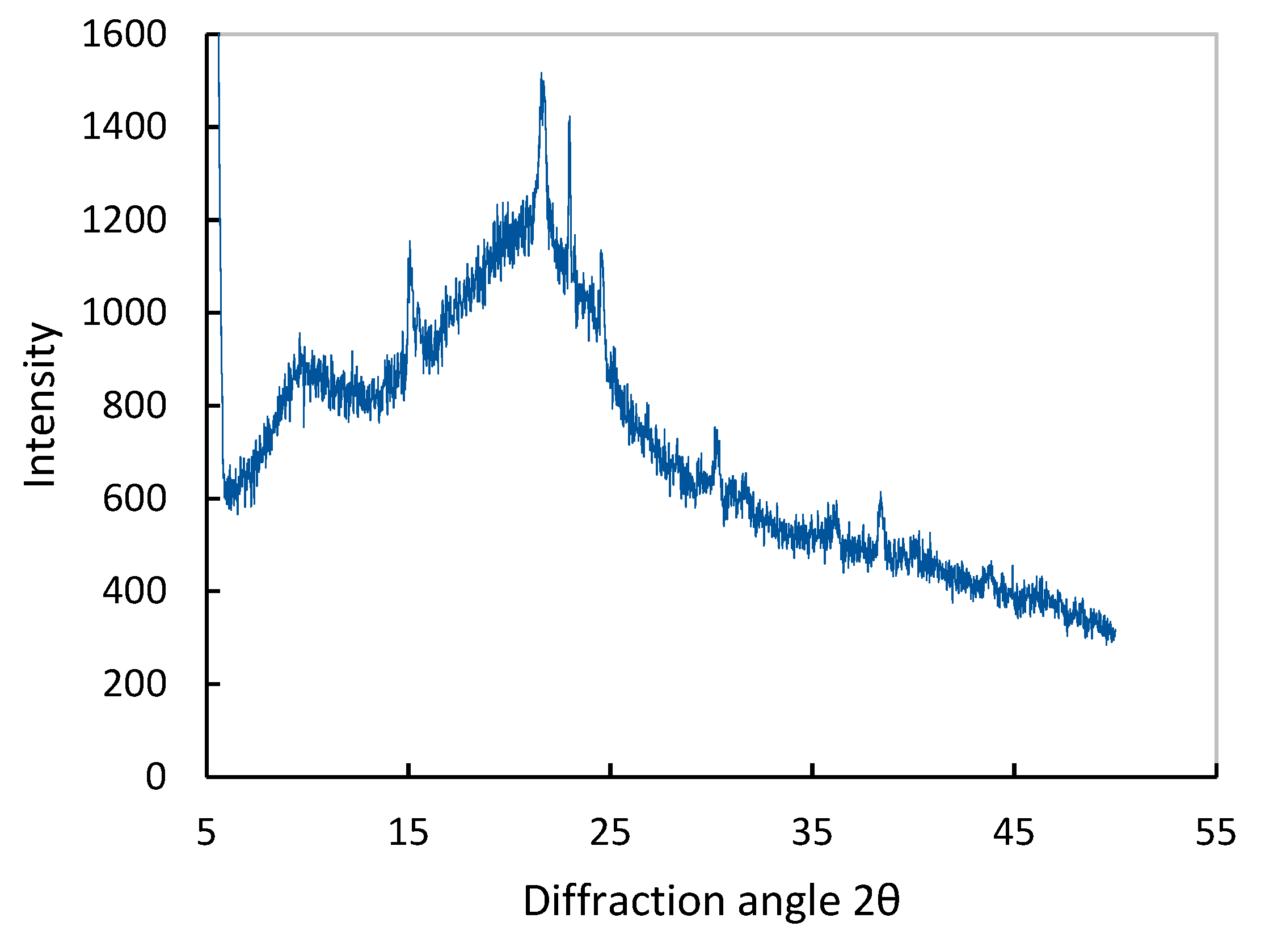
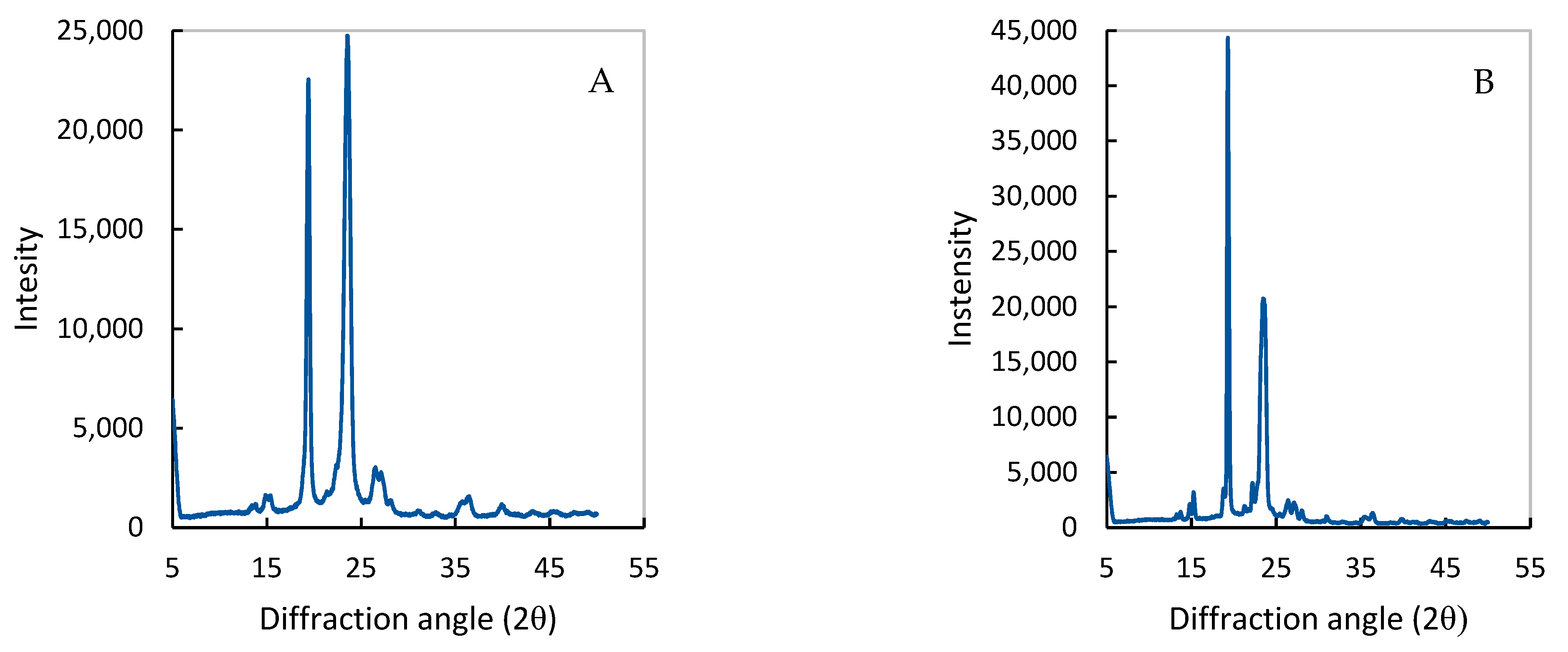
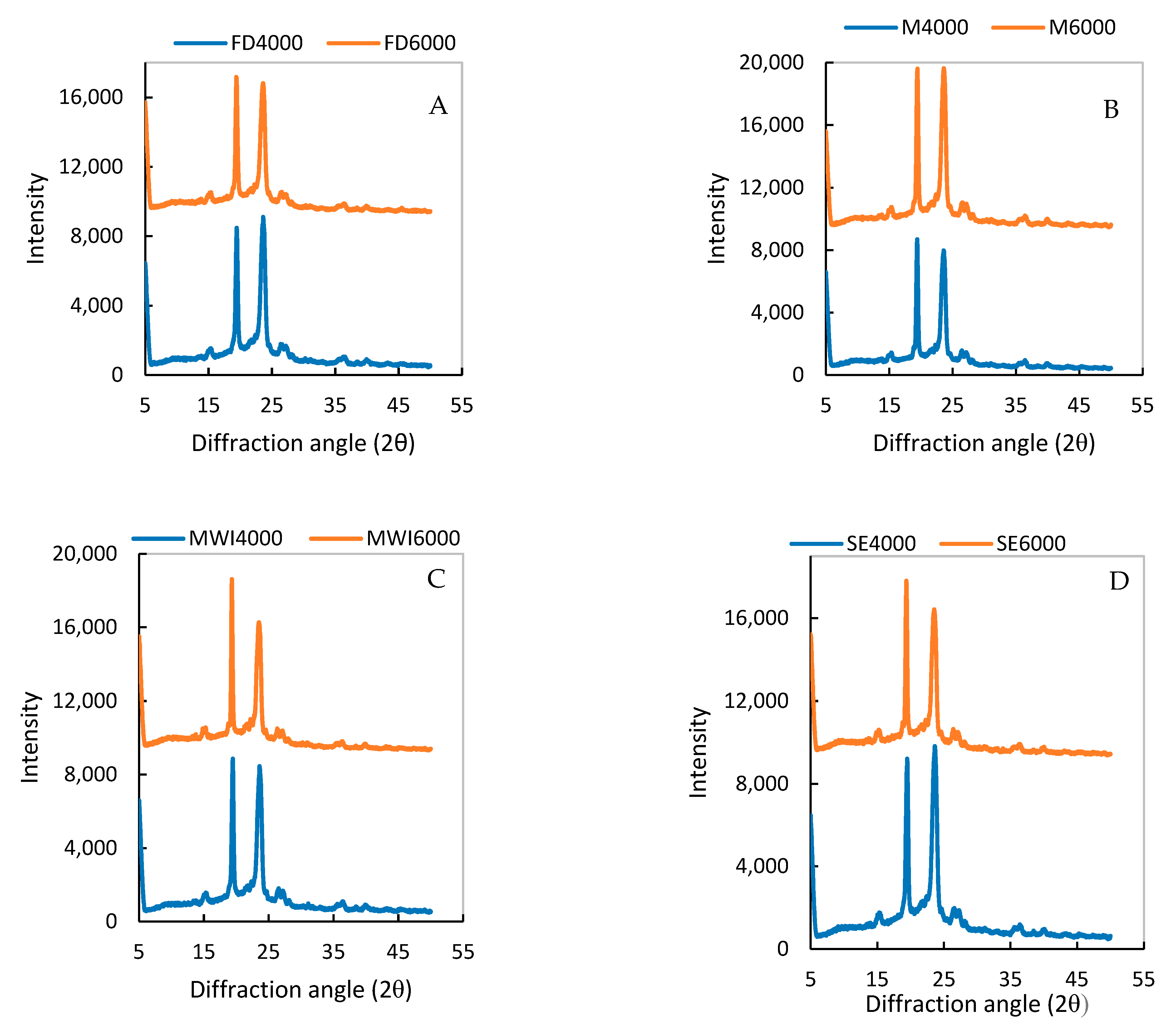
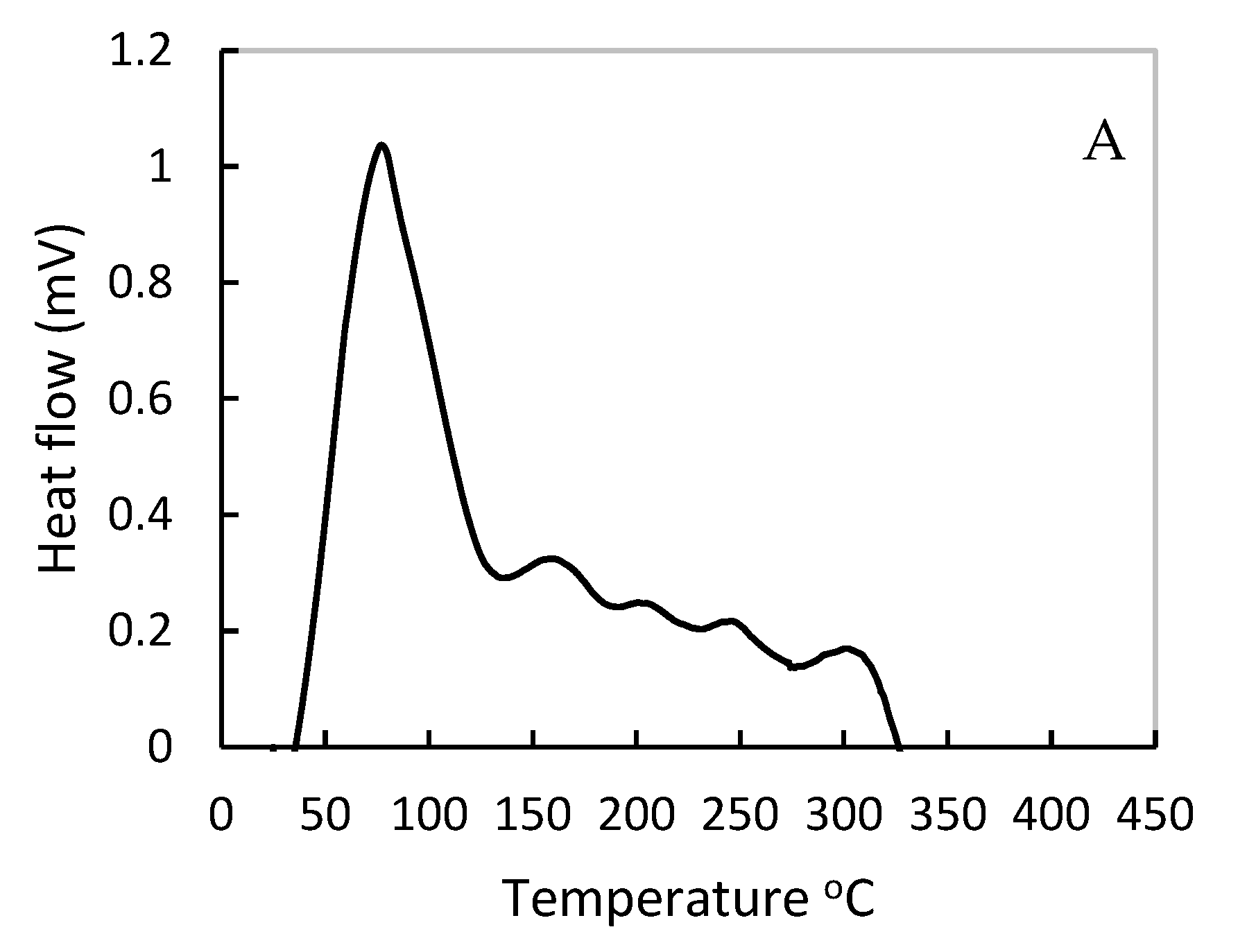
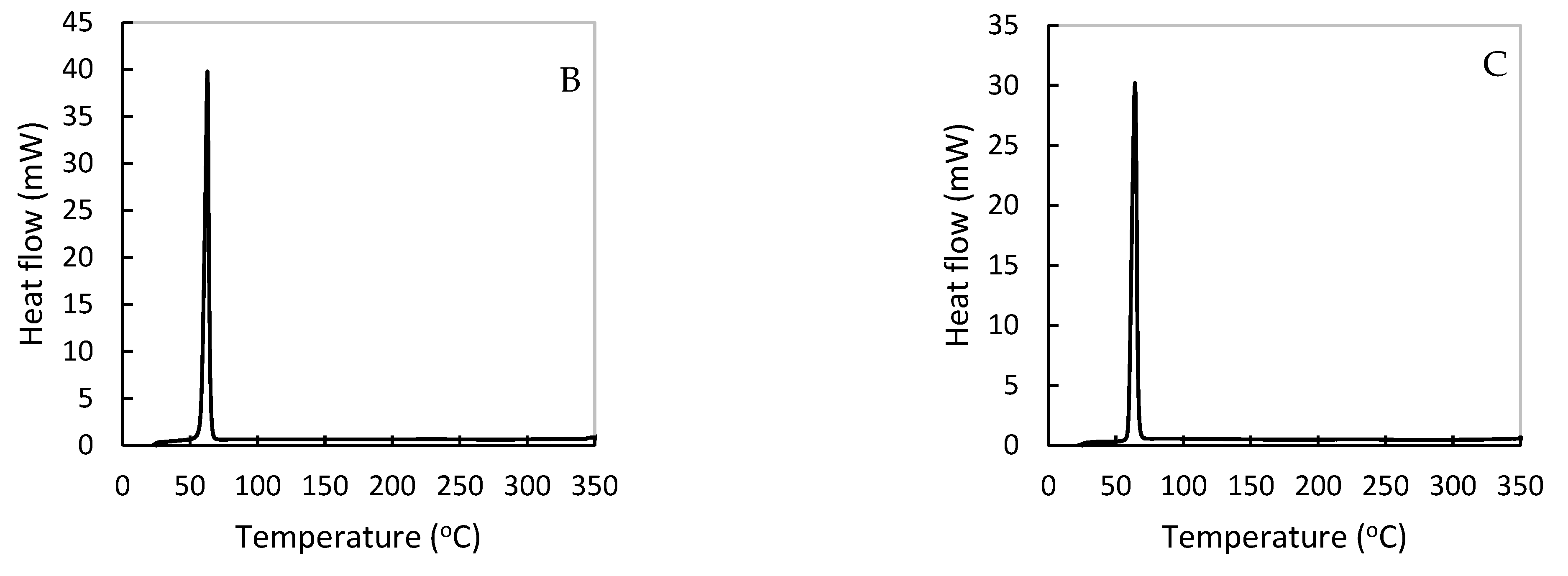
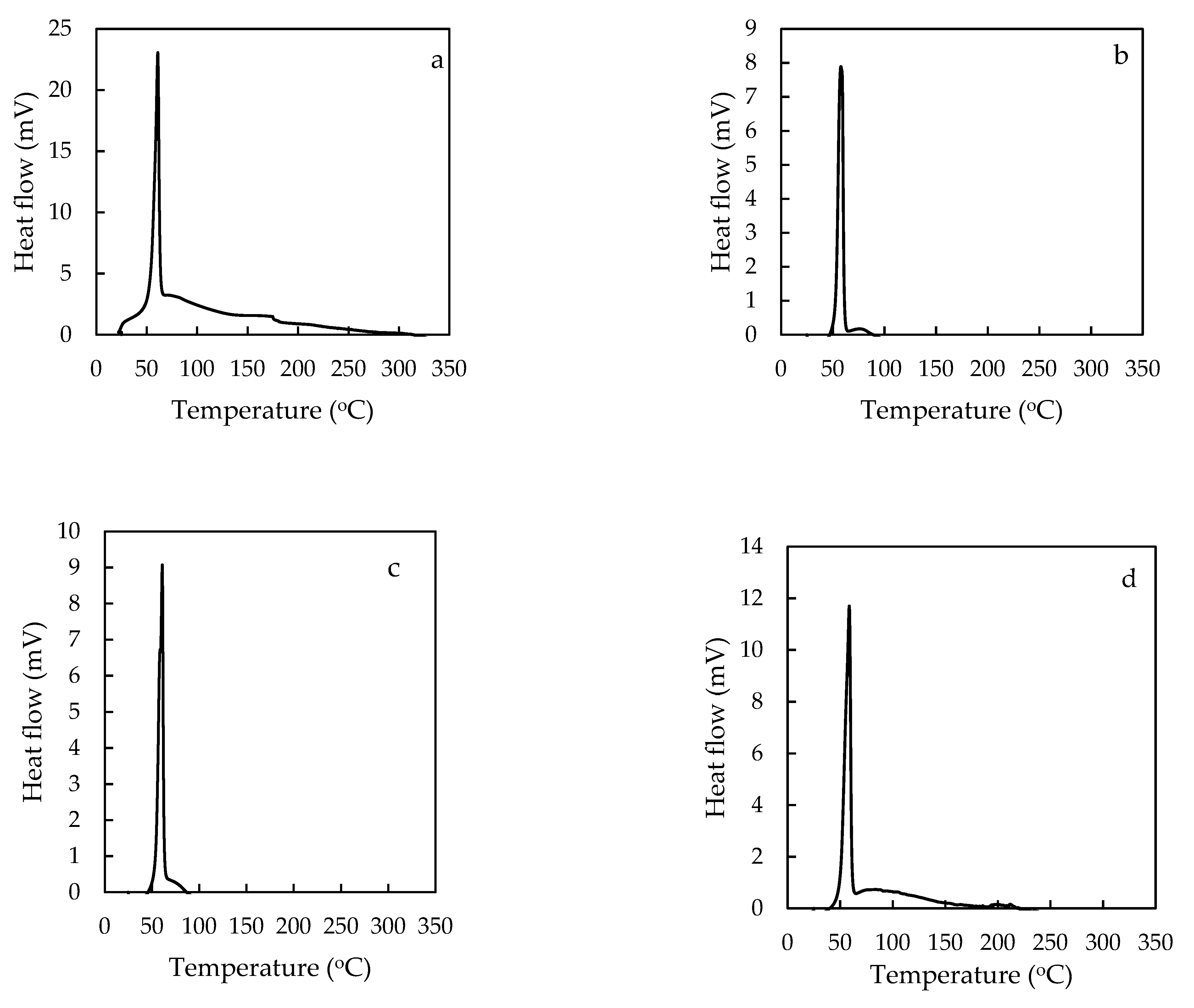
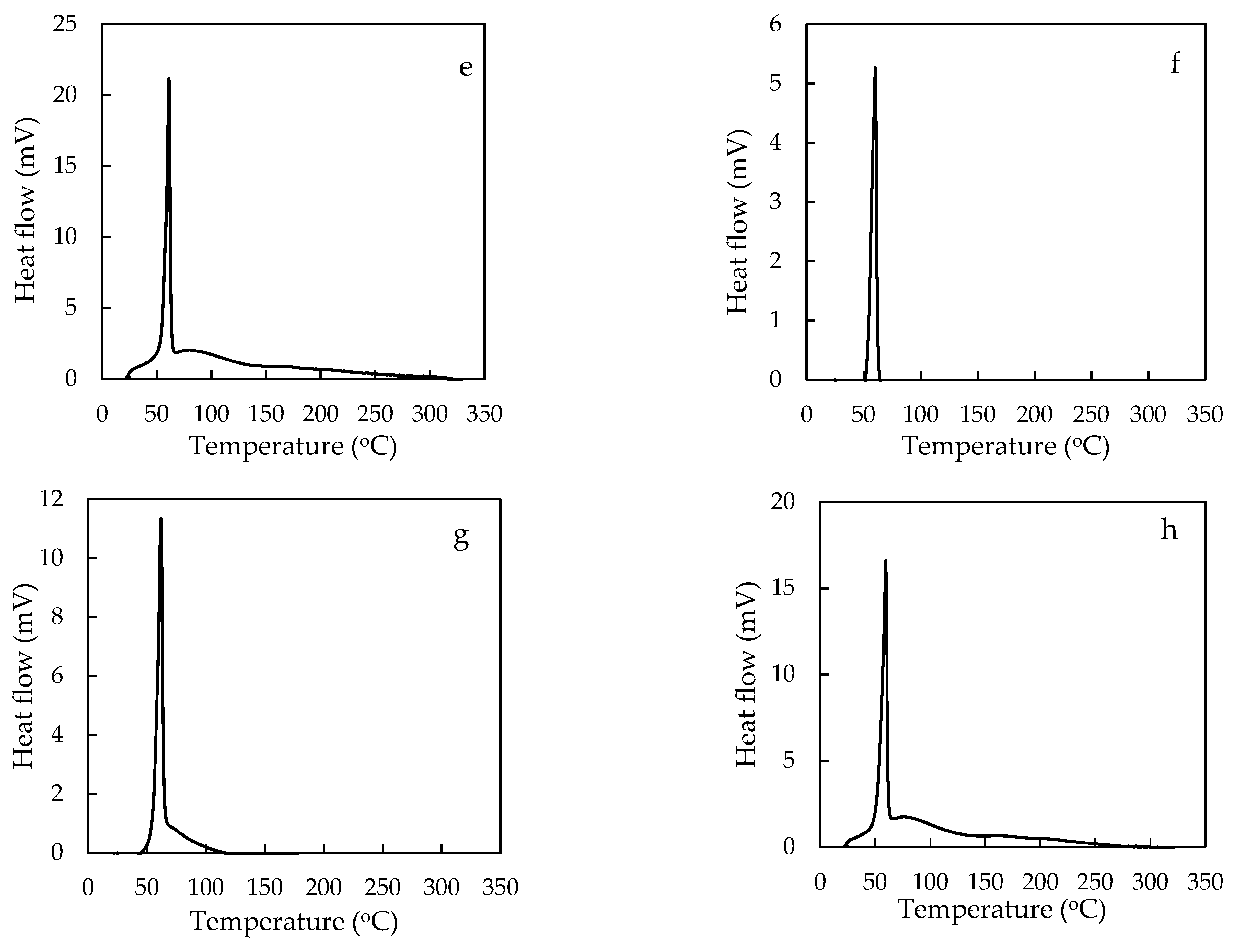
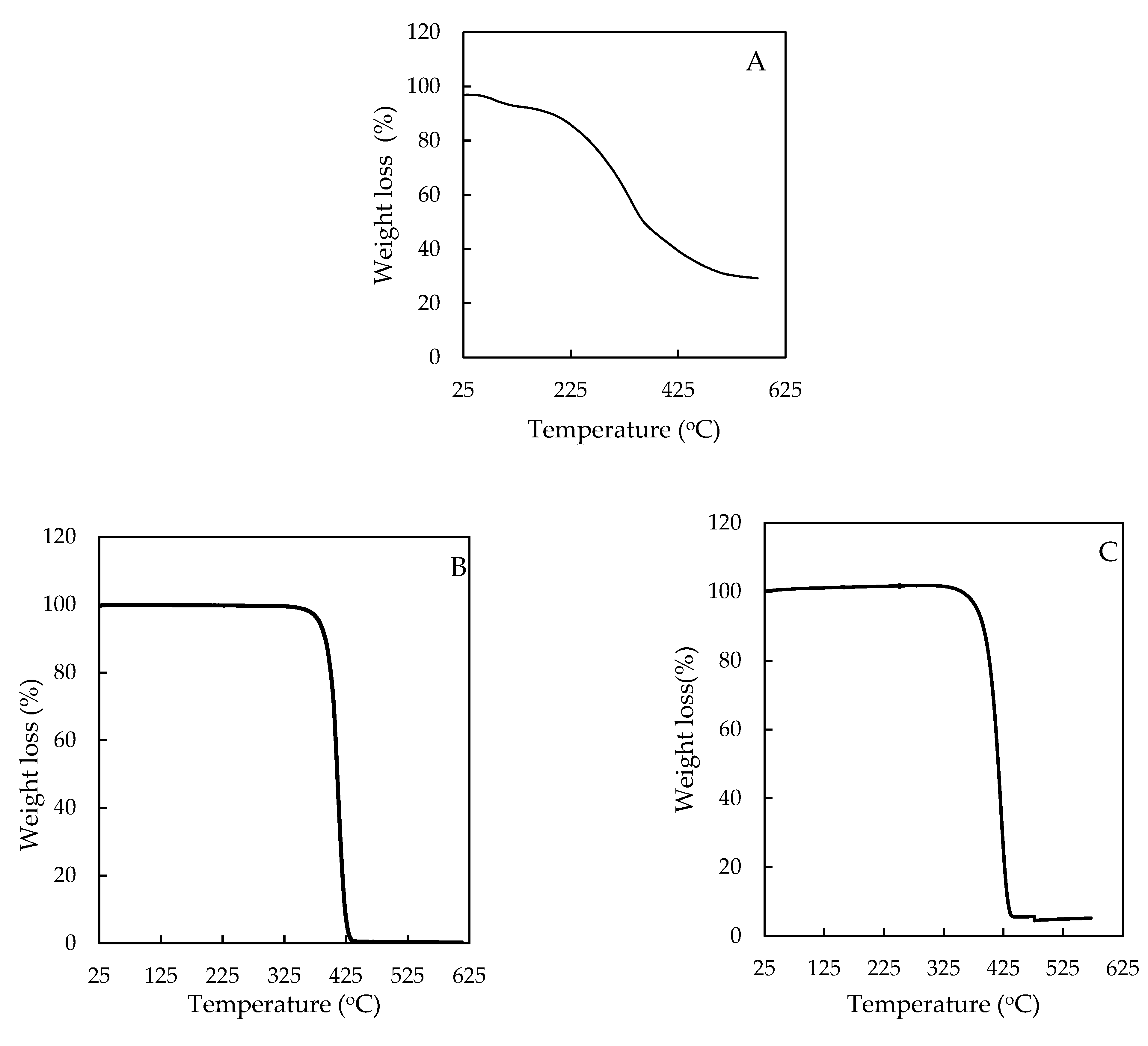
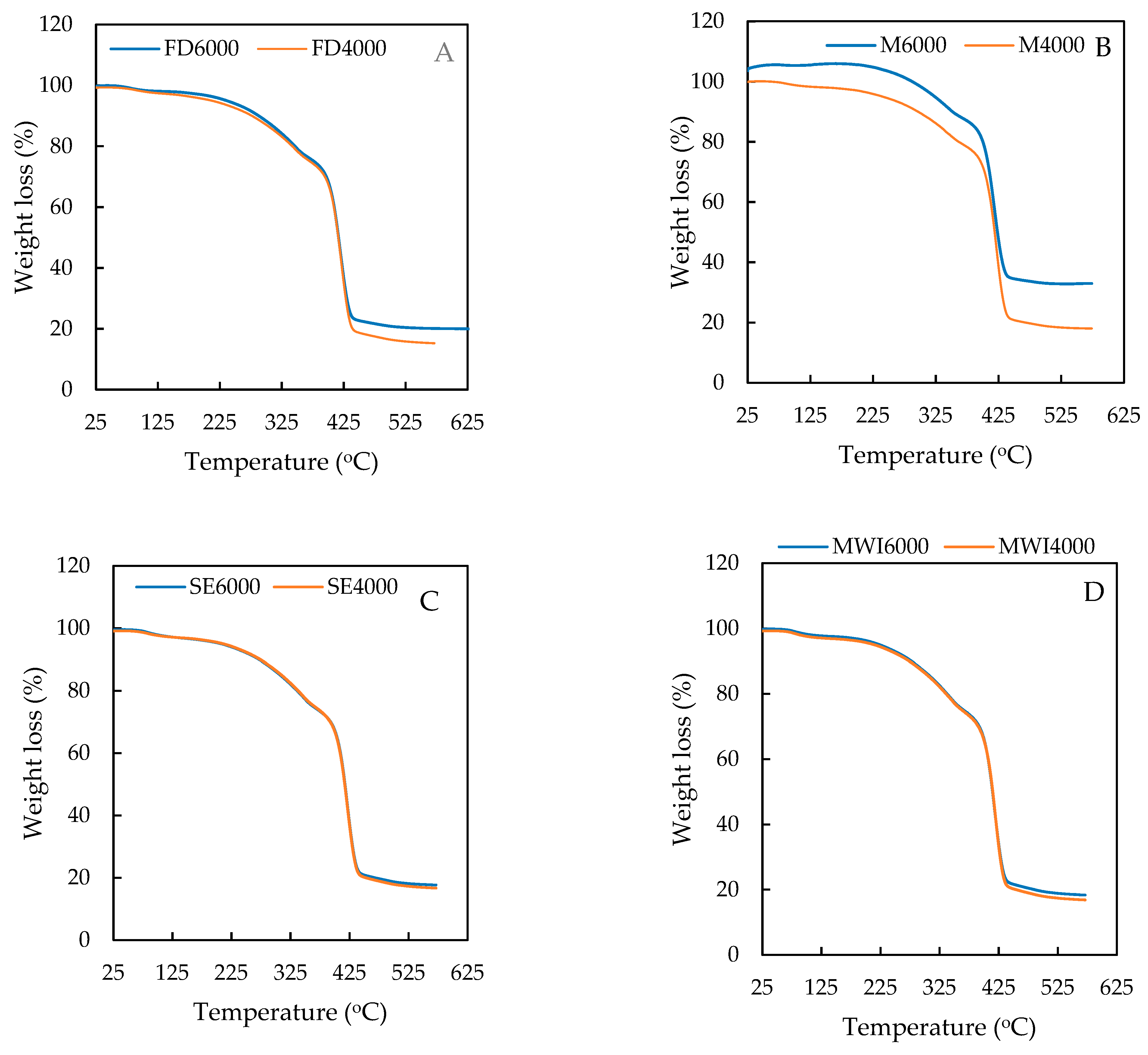
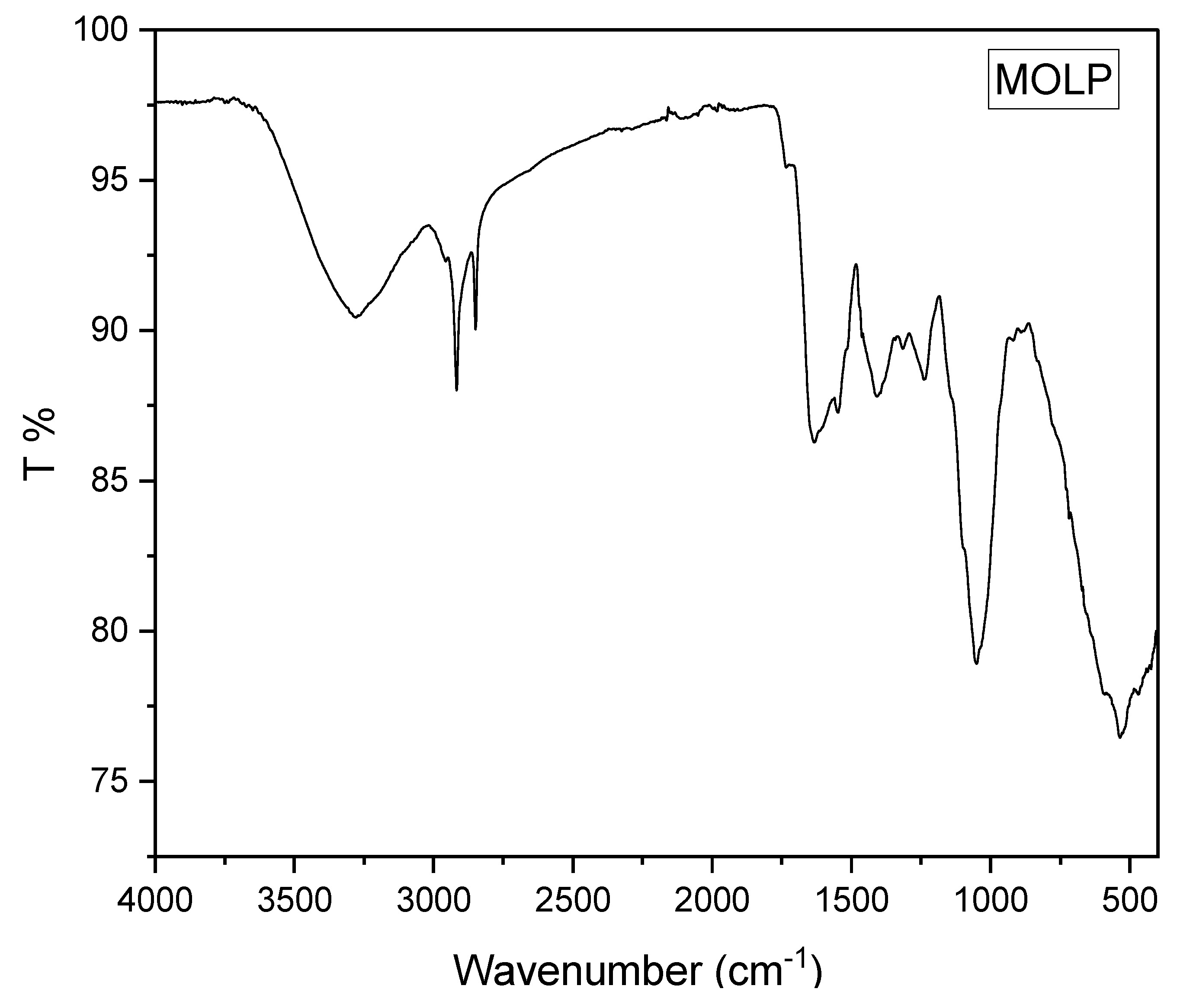
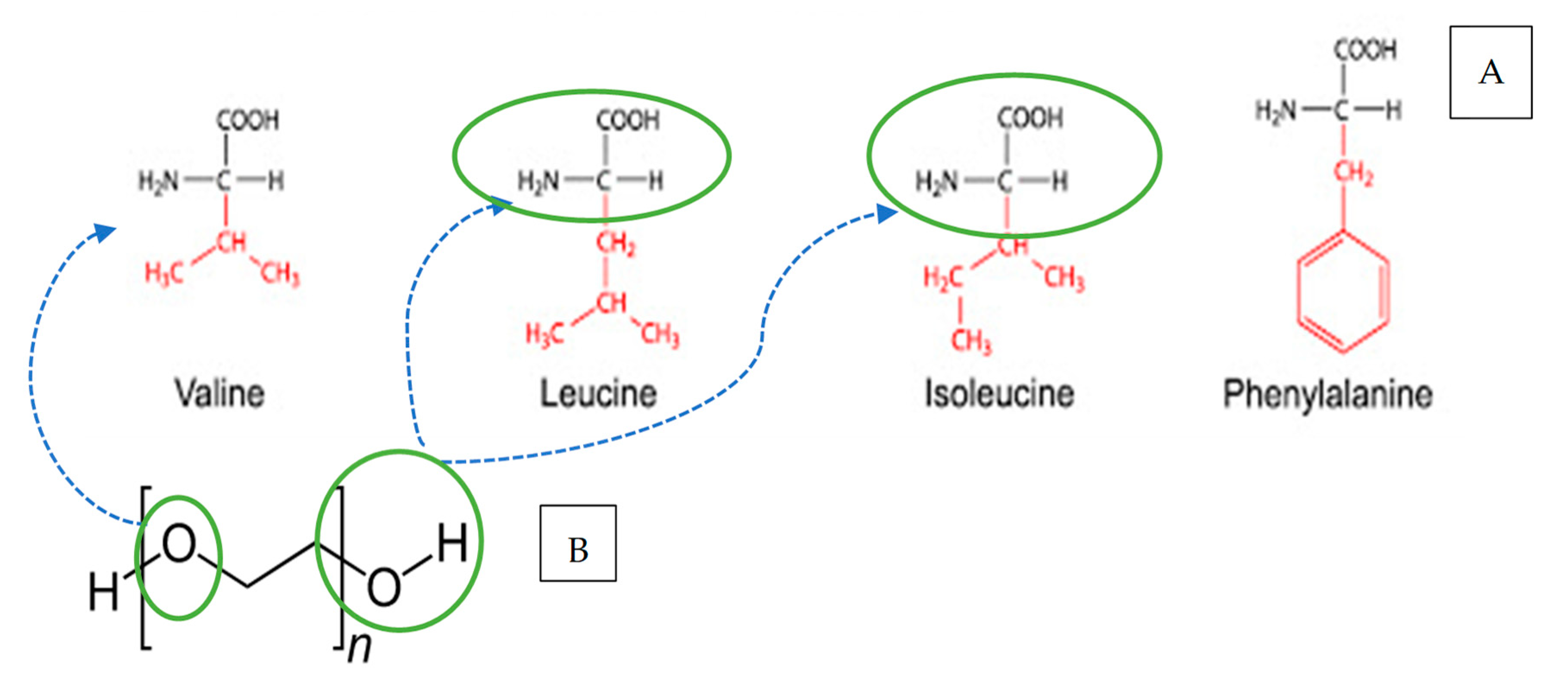
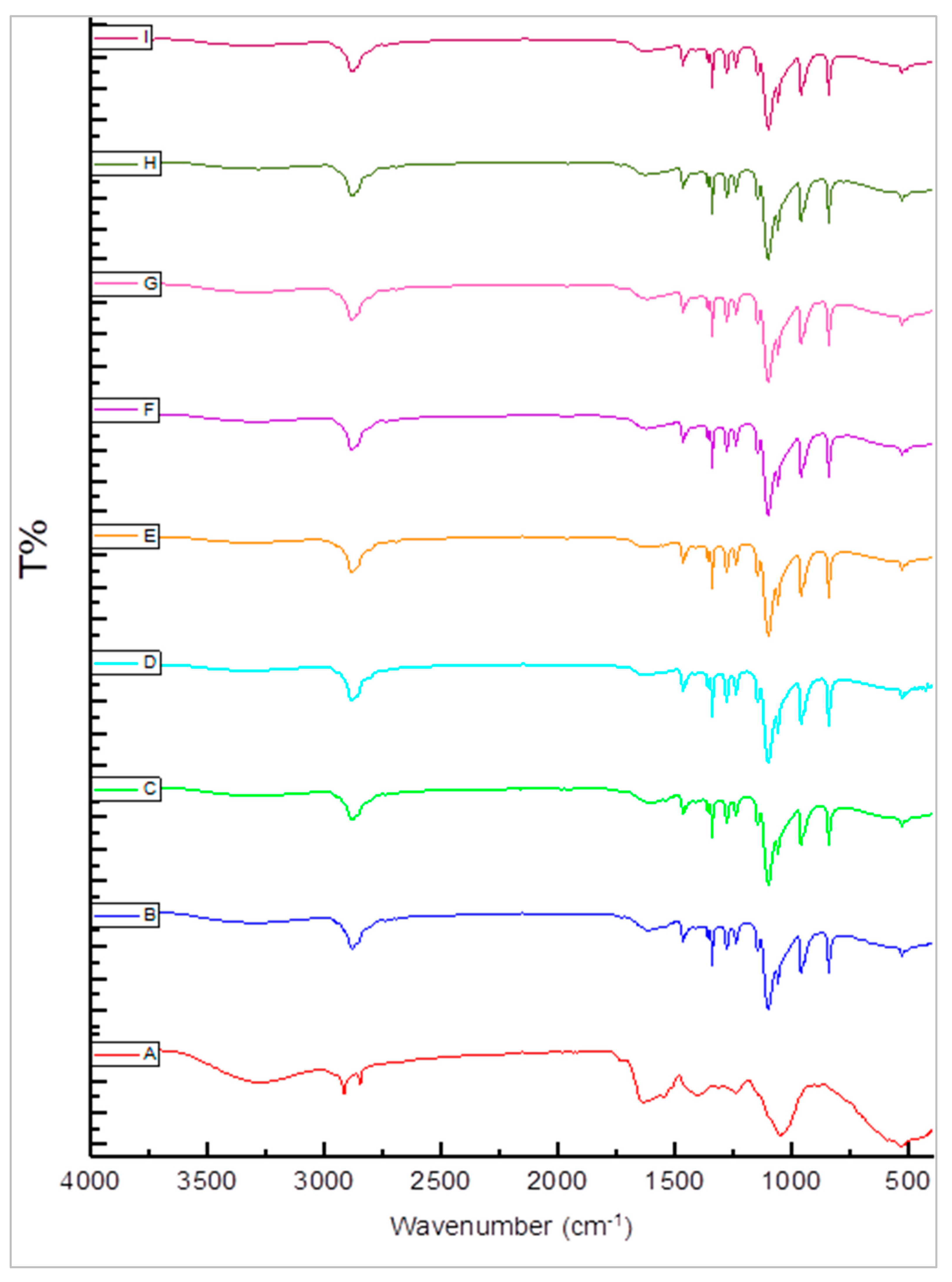
| Sample 1 | Peak | Tonset (°C) | Tpeak (°C) | Tendset (°C) | ∆H (J/g) | Tg (°C) |
|---|---|---|---|---|---|---|
| Pure MOLP | 1 | 44.14 | 80.09 | 128.23 | 111.35 | 37.27 |
| 2 | 128.23 | 159.35 | 179.97 | 5.0176 | 141.97 | |
| 3 | 185.86 | 210 | 230 | 1.54 | 180.69 | |
| 4 | 230 | 253.7 | 274.48 | 3.69 | 238.56 | |
| 5 | 274.48 | 312.56 | 345.79 | 23.84 | 277.72 | |
| Pure PEG4000 | 1 | 59.62 | 60.21 | 61.38 | 179 | 22.89 |
| Pure PEG6000 | 1 | 59.62 | 63.10 | 64.68 | 193.74 | 60.11 |
| PEG4000 | ||||||
| Freeze-drying | 1 | 53.35 | 57.78 | 60.80 | 94.45 | 64.01 |
| Melting | 1 | 56.24 | 59.10 | 61.40 | 102.21 | 62.85 |
| Solvent evaporation | 1 | 53.32 | 60.19 | 62.22 | 75.22 | 54.95 |
| Microwave irradiation | 1 | 55.10 | 59.48 | 61.29 | 108.44 | 52.84 |
| PEG6000 | ||||||
| Freeze-drying | 1 | 56.48 | 60.88 | 62.50 | 90.29 | 64.86 |
| Melting | 1 | 57.43 | 60.93 | 62.84 | 104.07 | 64.44 |
| Solvent evaporation | 1 | 55.76 | 60.96 | 63.05 | 95.59 | 50.34 |
| Microwave irradiation | 1 | 58.00 | 61.76 | 63.67 | 94.77 | 56.95 |
| Method 1 | Treatment 1 | ∆Mass Loss (%) 1 | Temperature Range (°C) |
|---|---|---|---|
| - | Pure MOLP | 4.96 | 32.21–151.07 |
| 44.16 | 151.07–371.86 | ||
| 24.91 | 392.16–531.96 | ||
| Pure PEG4000 | 98.22 | 356.4–483.84 | |
| - | Pure PEG6000 | 96.0 | 330.78–451.32 |
| Freeze-drying | PEG4000 | 1.93 | 25.06–130.87 |
| 22.19 | 130.87–369.82 | ||
| 59.88 | 369.82–569.78 | ||
| PEG6000 | 1.93 | 25.06–130.87 | |
| 22.19 | 130.87–369.82 | ||
| 55.02 | 369.82–569.78 | ||
| Melting | PEG4000 | 1.83 | 32.12–131.35 |
| 19.49 | 131.35–371.74 | ||
| 60.69 | 371.74–572.01 | ||
| PEG6000 | 1.27 | 24.97–111.48 | |
| 18.30 | 111.48–371.74 | ||
| 54.38 | 371.74–572.01 | ||
| Solvent evaporation | PEG4000 | 2.10 | 32.13–130.27 |
| 22.27 | 130.27–369.72 | ||
| 57.66 | 369.27–569.86 | ||
| PEG6000 | 2.10 | 32.13–169.82 | |
| 22.27 | 169.82–389.85 | ||
| 57.66 | 389.85–489.99 | ||
| Microwave | PEG4000 | 2.26 | 31.97–130.34 |
| 22.93 | 130.34–369.77 | ||
| 57.18 | 369.77–569.55 | ||
| PEG6000 | 2.26 | 31.97–130.34 | |
| 22.93 | 130.34–369.77 | ||
| 57.18 | 369.77–569.55 |
| Method | Carrier | Wavenumber (cm−1) |
|---|---|---|
| Pure MOLP | 3287, 2921.2, 2850.6, 1990, 1640.9, 1553.6, 1420.6, 1316.6, 1246, 1058.9, 530.95, 468.6 | |
| Freeze-drying | PEG6000 | 3380, 2883.59, 1466.43, 1359.72, 1341.67, 1279.27, 1241.01, 1146.89 1100.39, 1059.90, 961.28, 841.58, 528.43 |
| PEG4000 | 3315, 2893, 1628, 1467, 1342, 1280, 1241, 1104, 962, 842, 526 | |
| Melting | PEG6000 | 3361, 2892, 1634, 1467, 1342, 1280, 1241, 1101, 962, 842,531 |
| PEG4000 | 3289, 2891, 1634, 1467, 1342, 1241, 1104, 960, 840, 529, 427 | |
| Solvent evaporation | PEG6000 | 3424, 2888, 1634, 1468, 1342, 1280, 1242, 1105, 960, 842, 530 |
| PEG4000 | 3288, 2892, 1649, 1467, 1342, 1280, 1242, 1104, 960, 842, 531 | |
| Microwave | PEG6000 | 3351, 2891, 1652, 1467, 1467, 1342, 1280, 1149, 1103, 962, 842, 526 |
| PEG4000 | 3341, 2891, 1628, 1467, 1342, 1280, 1241, 1104, 961, 842, 532 |
Publisher’s Note: MDPI stays neutral with regard to jurisdictional claims in published maps and institutional affiliations. |
© 2021 by the authors. Licensee MDPI, Basel, Switzerland. This article is an open access article distributed under the terms and conditions of the Creative Commons Attribution (CC BY) license (https://creativecommons.org/licenses/by/4.0/).
Share and Cite
Tafu, N.N.; Jideani, V.A. Characterization of Novel Solid Dispersions of Moringa oleifera Leaf Powder Using Thermo-Analytical Techniques. Processes 2021, 9, 2230. https://doi.org/10.3390/pr9122230
Tafu NN, Jideani VA. Characterization of Novel Solid Dispersions of Moringa oleifera Leaf Powder Using Thermo-Analytical Techniques. Processes. 2021; 9(12):2230. https://doi.org/10.3390/pr9122230
Chicago/Turabian StyleTafu, Nontsikelelo Noxolo, and Victoria A. Jideani. 2021. "Characterization of Novel Solid Dispersions of Moringa oleifera Leaf Powder Using Thermo-Analytical Techniques" Processes 9, no. 12: 2230. https://doi.org/10.3390/pr9122230
APA StyleTafu, N. N., & Jideani, V. A. (2021). Characterization of Novel Solid Dispersions of Moringa oleifera Leaf Powder Using Thermo-Analytical Techniques. Processes, 9(12), 2230. https://doi.org/10.3390/pr9122230






